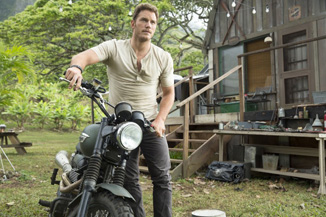Movie Review: Jurassic World
By Matthew Huntley
June 16, 2015
BoxOfficeProphets.com

Trevorrow’s Jurassic World, on the other hand, merely brushes over the science and is keener on action and spectacle. This isn’t necessarily a bad thing, though, and the movie actually works quite well as a silly summer blockbuster. Given that this is the fourth Jurassic Park picture (so far), and the first one to come out in over a decade, this was a pleasant surprise.
Story-wise, anyone familiar with the original will be able to see Jurassic World more or less tells the same one, right down to the type of characters who inhabit it. The movie’s four screenwriters - Rick Jaffa and Amanda Silver, Trevorrow and Derek Connolly - do little to hide the similarities. Jurassic World once again takes place on the island of Isla Nublar, off the coast of Costa Rica, where the original Jurassic Park has been given a technological makeover and is now a fully functional tourist destination. There are rides, petting zoos, giant display windows, water shows, restaurants, souvenir shops, etc., all featuring real-life dinosaurs, which have been brought back to life via DNA extracted from mosquitoes (you know the story).
As successful as the park is, Operations Manager Claire Dearing (Bryce Dallas Howard) - she’s basically this movie’s version of John Hammond (Richard Attenborough), the founder of Jurassic Park - tells potential investors that in order for the park to remain viable and relevant to the public, they have to deliver bigger, louder and faster creatures, which means genetically modifying the current ones. And so the research and science teams have “designed” a new species called “Indominus Rex,” which is a combination of the Tyrannosaurus Rex and other species, including a fish that allows the dinosaur to camouflage itself (a feature that will no doubt play a part later on).
Obviously, Claire and the park’s primary financial backer, Simon Masrani (Irrfan Khan), are in over their heads and, once again, the movie poses the question of just how much man should play with nature (this has always been one of the series’ running themes). And of course, there’s one character who suspects genetically modifying dinosaurs was a bad idea all along. He’s Owen Grady (Chris Pratt), a former marine and now a Velociraptor trainer who believes he’s made a personal connection with the lizards. In fact, he controls them so well with his clicker and hand gestures that Vic Hoskins (Vincent D’Onofrio), head of the park’s security division and your typical money and power-hungry machismo, sees this as an opportunity to put the raptors in the field as military weapons. Given his questionable ethics, we’d be very surprised if Hoskins survives the entire movie.
Two characters we can pretty much guarantee will survive are Claire’s nephews, who fulfill the roles of the token children who must be placed into mortal danger (all previous Jurassic Park movies had them too). They are Gray (Ty Simpkins), a sensitive dinosaur enthusiast, and his older brother Zach (Nick Robinson), who’d rather be gawking at girls than babysitting his younger sibling.
Based on Hollywood’s traditional action-movie formula, not to mention the specific Jurassic Park formula, we can pretty much anticipate the plot events: a) the Indominus Rex will escape its cage and run rampant, causing widespread panic (it will also eat a whole bunch of people); b) Gray and Zach will get left alone and must find ways to forge for safety, drawing them close together as brothers; c) Claire and Owen will set aside their moral differences and come together to find Claire’s nephews, with romantic tension brooding underneath; d) a full-scale climax with lots of screaming people and out-of-control dinosaurs will ensue; e) finally, the bad guys will get their comeuppance and the heroes will realize what’s really important in life.
So the plot contains no real surprises, but do we really care about the plot? We know it simply exists to bind the characters together so they can either be chased, perform death-defying stunts, or be eaten. Frankly, in the context of a third sequel like Jurassic World, which we expect to function purely as an action-adventure movie, I was okay with it simply recycling the original’s plot instead of coming up with one that was unnecessarily laborious. This allowed the movie to live and breathe freely as a platform for action and special effects, which are actually quite superb. Along with the editing, sound design and cinematography, they generate at least four scenes that truly awe and shake us, not unlike a real amusement park ride. These include Gray and Zach escaping from the Gyrosphere ball; Masrani flying a helicopter in a storm of pterodactyls; and a breathtaking dinosaur battle at the end, complete with two slow motion build-ups. It’s all cheesy stuff, yes, but it provides a real rush.
And a rush is exactly what we want from a movie like Jurassic World, which is no easy task, especially these days when Hollywood indoctrinates us with action and special effects. Trevorrow and his team utilize their resources effectively, and even though it’s light on intelligence and originality, for a dinosaurs-run-amok-and-chase-and-eat-people movie, it’s fun and exciting.